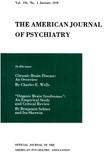A STATISTICAL STUDY OF ONE HUNDRED NEUROPSYCHIATRIC CASUALTIES FROM THE NORMANDY CAMPAIGN
Abstract
1. A comparative study of 100 neuropsychiatric combat casualties and of 100 control cases is reported.
2. There was a slight preponderance of older men in the neurosis group.
3. The incidence of poor family background and early environment was about twice as great in the neurosis group.
4. The average number of neurotic traits was higher in the neurosis group.
5. Many more cases in the neurosis group gave a history of treatment for some nervous condition in civilian life and in the Army prior to combat.
6. The application of (4) and (5) for screening purposes would have eliminated 52 men of the neurosis group from combat, 12 of the control group.
7. The potential neuropsychiatric casualty shows a tendency to be more nervous, inclined to worry, dependent and seclusive than the sturdy soldier.
8. Conflicts with the law and alcoholic habits were more frequent in the control group.
9. Religious tendencies were more prevalent in the neurosis group.
10. Discontent with society and with the Army was slightly more in evidence in the neurosis group.
11. Physically wounded soldiers showed less reluctance to discuss their experiences than the psychically wounded.
12. The limitations of the present study and reasons for considering its conclusions tentative until further tested are discussed.
Access content
To read the fulltext, please use one of the options below to sign in or purchase access.- Personal login
- Institutional Login
- Sign in via OpenAthens
- Register for access
-
Please login/register if you wish to pair your device and check access availability.
Not a subscriber?
PsychiatryOnline subscription options offer access to the DSM-5 library, books, journals, CME, and patient resources. This all-in-one virtual library provides psychiatrists and mental health professionals with key resources for diagnosis, treatment, research, and professional development.
Need more help? PsychiatryOnline Customer Service may be reached by emailing [email protected] or by calling 800-368-5777 (in the U.S.) or 703-907-7322 (outside the U.S.).



